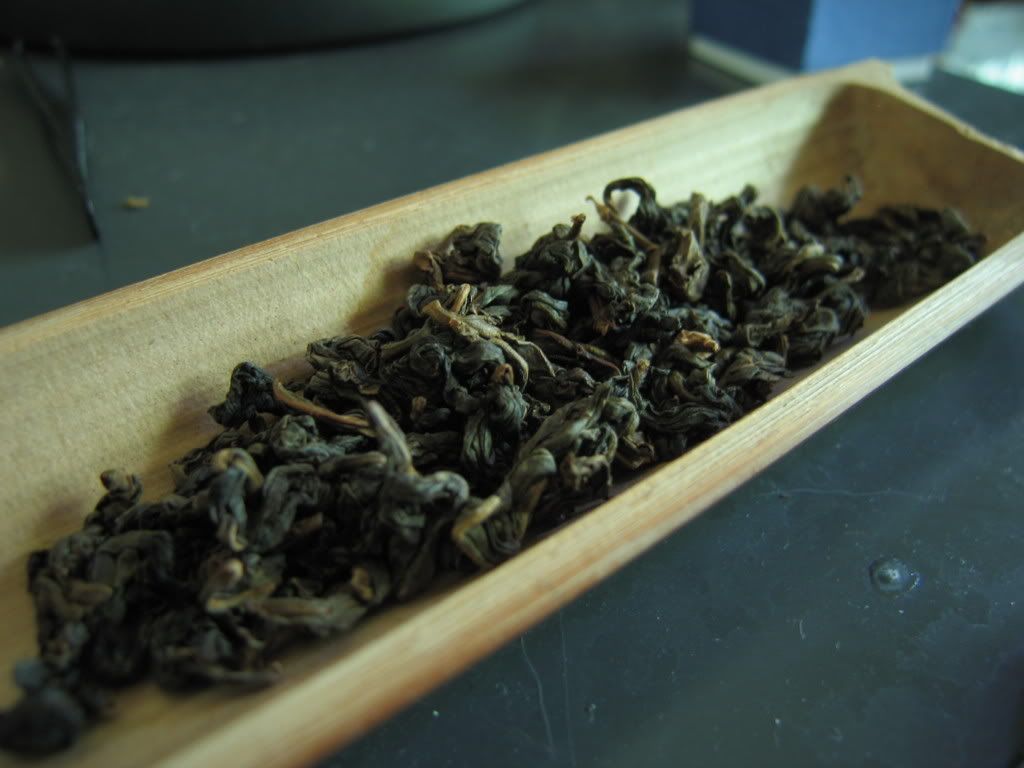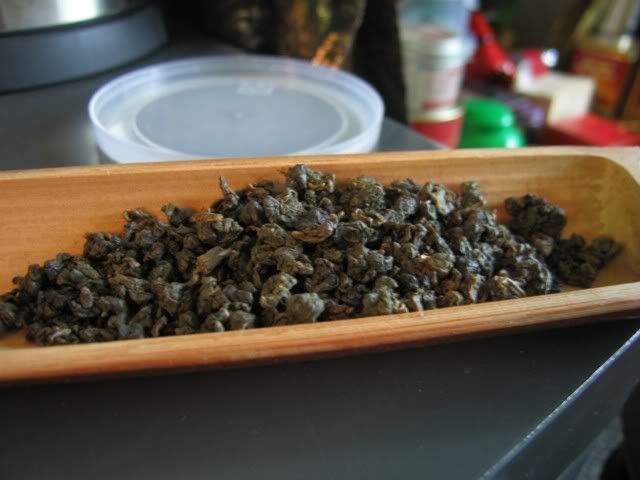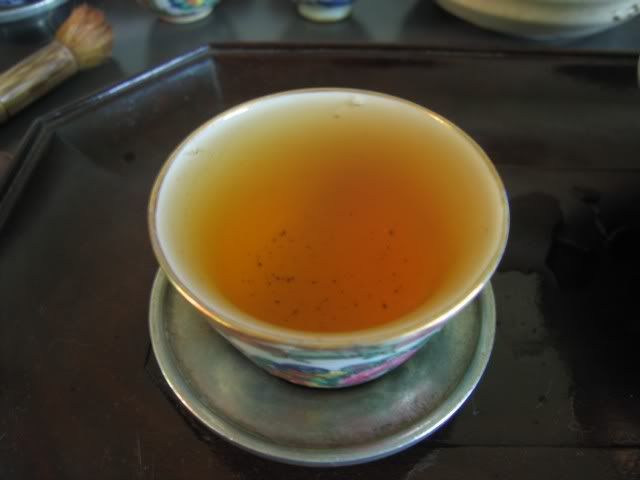
Before I get married…. shared with some friends and family.
See you all on the other side 🙂


Before I get married…. shared with some friends and family.
See you all on the other side 🙂
Categories: Old Xanga posts
Tagged: administration, aged oolong
I drank some tieguanyin today, which I tasted very early on in this blog’s life. That’s basically two years ago when I last tried it, and looking back at those comments, it’s really rather interesting how my view of teas in general have changed.
Two years on, the tea is still good. It’s still in the same tin, although its contents mostly gone. The tea is developing a little tartness that I don’t think it had before. There’s a more subdued aroma now — the floral sort of quality is certainly gone, or at least dissipated. However, it’s also not bitter anymore — bitterness seems to go out of the window after a few years.
Is this tea more enjoyable than it was two years ago? That’s quite hard to say. After all, it has lost the freshness of a new tea. It will not satisfy those who are looking for a nice green cup of tieguanyin. Yet, I think nowadays my body likes these things much better than fresh tea — maybe I’m getting stale myself, so I require stale teas.
Categories: Old Xanga posts
Tagged: aged oolong
I’ve finally started to drink tea more regularly again (instead of sipping large cups of black using a big pot). I tried the same tea two days in a row, something I don’t normally do, and used two different pots for it. The tea in question is my “wet stored” tieguanyin from Taiwan. The pots are, respectively, a zhuni pot I bought from Taiwan, and a zisha pot I got from Japan (the one with the funny lid). I thought of it as a bit of an experiment — how different clays change a tea.
And change it did. All other things being equal, the tea brewed in the zhuni is a little more aggressive, wihle the zisha one (especially since this pot is relatively low density) is, I think, softer. I’m not sure if softer is necessarily a good thing, and I think that should I be making, say, a “dry stored” aged oolong, the softness might take too much away from the tea. For this “wet stored” tea however, it works just fine — gets rid of some of the pungent flavours.
I tend to think it’s better, in general, to use a lower density pot for teas that have more “mixed” flavours, or possibly unpleasant aspects — say, a young puerh that is bitter or a wet stored tea. For teas that are high in aroma though, a zhuni will probably serve better — helps concentrate the aromatics without taking too much away.
Of course there’s the possibiliy that all this is just placebo — and there’s really no way for me to know if that’s the case. Oh well, let’s just pretend there is 🙂
Categories: Old Xanga posts
Tagged: aged oolong
Weddings are sometimes fun, but tea meetings with like minded addicts are always enjoyable. It was nice escaping to the clear blue skies of LA, going to the wedding of my cousin who gave out jasmine blooming tea balls as wedding favours, and then, on Sunday, meeting with a few of those from the LA tea group whom I’ve corresponded with before.
Two of them I’ve already met — Jason and Phyll — but the others I’ve only emailed on a number of occasions and exchanged teas with, but never met. It’s always good to know who is sending you leaves in sealed foiled packs. It gives me a little more confidence in drinking stuff coated with mysterious white powder sent by them :).
We started with two greens, each different and rather interesting, especially when we experimented with the “mineral rocks” (ch. maifanshi) that you can get from Asia which are supposedly used for adding minerals to water. They do seem to make a difference, even when there’s only one rock in the fairness cup and thus the water is only exposed to the rock for a short amount of time. I’ve always been rather skeptical of the ability of these rocks to do much of anything, mostly because they are exposed to the water for not very long periods and I wonder about the solubility of the minerals in these things… but I must say I’m sold.
After the two greens, we had two aged oolongs (one of mine from the Candy Store, and one an aged baozhong). The little rock still did the trick there, as we tried our tea with and without the rock…. when it’s in the fairness cup, the tea tasted better. Odd, and possibly placebo…
I think we ended with two Wuyi teas, one is simply called “Laoshucha” or “old tree tea” from Will, and another which is a dahongpao. The laoshucha clearly does have some nice qi.
If I seem to be short on the description of teas… that’s because I wasn’t paying all THAT much attention to them. It was far more interesting to meet old friends again, and in some cases, meeting friends whom I’ve only known through the cyberspace until now. Tea, after all, is a social drink, and it is nice to be able to do it finally in its proper setting — among a group of friends, instead of drinking alone. It might be nice to finally be able to live in a city with more than a plurality of tea drinkers whom I can regularly meet with again, but until then… there’s always this blog.
Categories: Old Xanga posts
Tagged: aged oolong, friends, travel, wuyi yancha
It’s often not too easy to find the right teas to introduce people to making tea in the way we often do. Stuffing a pot full of leaves and then brewing is, usually, not what most people had in mind when they think of “tea”. Selection thus becomes extremely important — because picking the wrong tea can forever turn somebody off and make for, generally speaking, a very bad outing.
I hosted two people today from Central Asia. They’re, of course, not new to tea at all. Drinking tea is an age old tradition in the steppes, and they are quite familiar with tea — except, of course, tea is very different there. It’s usually black tea, made over a samovar with an extremely concentrated liquor, but then, they dilute it with water. Tea is also served with an immense amount of pastry and other foods. Not quite the same thing.
So, what to serve these new guests? It’s always a bit of a difficult question, made all the more difficult by my lack of good green tea or white tea. The only white tea I have are about three years old, which, actually, might make them good candidates, because I find some of the higher oxidized white teas actually do fairly well with age. Greens, of course, don’t do so well, and besides, I don’t have anything ready.
That leaves oolongs and puerhs (leaving out blacks — I figured they have enough black teas on their own). Puerh is almost always out of the question. Raw, young puerh is always a no go with people new to Chinese teas, or at least I think it should always be that way. While sometimes they can be nice, the downsides are high and I don’t like running those risks. Cooked or older puerh can be a possibility, but without knowing the tolerance of my guests for, say, mud, it’s hard to gauge.
That leaves oolongs. That is still quite a variety of stuff. I considered serving them the remaining sample D of dancong, but there wasn’t enough to serve a party of four sufficiently. It has to be something I have a little more of, something that I can use my bigger oolong pot for. I have some young gaoshan oolong that will probably do, and I think under other circumstances, I might’ve just brewed those. But… I don’t like new gaoshan oolong much. They’re, well, rather unpleasant after a few cups. They can also be a little bitter if you’re not used to that sort of thing.
I finally settled on a gaoshan oolong after all, but one that is aged maybe 5 years or so. It still tastes mostly like a gaoshan oolong, but it has lost a good bit of its bitterness (only really noticeable if you try very hard to overbrew the tea). It’s a little more mellow that way, and a little more easy going. It also paired well with the eventual food we had, including cakes, fruits, etc. We were accompanied by an endless swarm of flies (we just had a storm two days ago and it seems like the flies bred like nuts recently).
The tea held on for the whole afternoon, probably 15 or 20 infusions in all. I originally thought we could move to an older tea after a while, but the guests decided they like this one just fine… and we just kept going with it, chatting about various things all the while.
So, the lesson I learned is that slightly aged oolongs can be great for guests. There was another lesson learned today, but that’s for tomorrow.
Categories: Old Xanga posts
Tagged: aged oolong
Yesterday before we parted ways, Sherab gave me some tea from a canister he brought over

The canister of tea is clearly marked — it’s some competition tea from Taiwan from 1991. That’s a good 17 years ago, and he obtained it from a friend of his who’s been holding on to it for a while now. And now, I got a bit of it. Obviously impatient, I brewed it today.

The tea gives me a good indicator of what to expect from, say, an aged oolong that’s about 15 years old, stored, probably for much of its life, in an air tight, possibly sealed environment. The tea is, compared to most of the stuff I’ve purchased in Taiwan, quite green, but by no means young — you can easily feel the aging in this tea, as there’s no bitterness to be had, and also plenty of sweetness. There’s also a light, very faint sour note, but given the amount of leaves I used (generous, for the pot anyway) and the sometimes rather long infusions I subjected it to, it’s really nothing. I have a baozhong that is at a similar stage of development — possibly a little younger, but not much.
This does tell me though that something around 15 years old and stored in, say, canisters for most (if not all) of its life is going to taste something like what I just did today, which is quite fine, as it is. If the final goal of all this aging is to obtain a tea that is long lasting, easy to brew, sweet, and most importantly, without the need of reroasting, then this gives me a good confidence boost that it is, indeed, possible to obtain such teas via one’s own aging. The biggest temptation, of course, is to drink them too early… and that, I think, is a shame, for nicely aged oolongs can be truly wonderful.
Thanks Sherab for the sample 🙂
Categories: Old Xanga posts
Tagged: aged oolong
Yesterday before we parted ways, Sherab gave me some tea from a canister he brought over

The canister of tea is clearly marked — it’s some competition tea from Taiwan from 1991. That’s a good 17 years ago, and he obtained it from a friend of his who’s been holding on to it for a while now. And now, I got a bit of it. Obviously impatient, I brewed it today.

The tea gives me a good indicator of what to expect from, say, an aged oolong that’s about 15 years old, stored, probably for much of its life, in an air tight, possibly sealed environment. The tea is, compared to most of the stuff I’ve purchased in Taiwan, quite green, but by no means young — you can easily feel the aging in this tea, as there’s no bitterness to be had, and also plenty of sweetness. There’s also a light, very faint sour note, but given the amount of leaves I used (generous, for the pot anyway) and the sometimes rather long infusions I subjected it to, it’s really nothing. I have a baozhong that is at a similar stage of development — possibly a little younger, but not much.
This does tell me though that something around 15 years old and stored in, say, canisters for most (if not all) of its life is going to taste something like what I just did today, which is quite fine, as it is. If the final goal of all this aging is to obtain a tea that is long lasting, easy to brew, sweet, and most importantly, without the need of reroasting, then this gives me a good confidence boost that it is, indeed, possible to obtain such teas via one’s own aging. The biggest temptation, of course, is to drink them too early… and that, I think, is a shame, for nicely aged oolongs can be truly wonderful.
Thanks Sherab for the sample 🙂
Categories: Old Xanga posts
Tagged: aged oolong

This is a tea I bought from the candy store but which I never drank… the first tea I got from them, actually. At that time, I was asking them for “aged oolong”, and got this. I figured it was not old enough — so asked for the other things, which, of course, led to a treasure trove…
This tea was well sealed, and I finally opened it today. When brewed….

Light in colour, smells young, but tastes a little older than very young. In fact, there’s that typical greennness in the taste/flavour — but you can tell it’s gone down from when it was first made. I am guessing this tea is maybe 3-5 years of age. Instead, the sweetness is more obvious than otherwise, and overbrewing does not produce the nasty, nasty grassy notes that you sometimes get with Taiwanese tea.
I wonder if this is a good candidate for personal storage — I have a feeling it could be, given the right conditions.
Yet, this tea is also more expensive than most of their older tea, which begs the question — why bother??
Categories: Old Xanga posts
Tagged: aged oolong, Taiwan oolong
I had some aged shuixian today. The first thing that came to mind when I tried it is…. seems like the tea has improved.
I’m using the same pot as before, so I am guessing the water/kettle has something to do with it (lighting conditions was awful today for pictures). There’s a more spicy taste to the shuixian than I previously remembered — something that, given more intensity, will start approaching the taste of the mystery aged oolong I have.
So maybe, after all, Tiffany is right, and that tea is an aged shuixian of some sort, aged somewhat carelessly. This tea is only about 5-10 years old, according to the person who sold it to me. I sometimes wonder if I can find old teas stored away somewhere in Wuyishan…. we can always dream, I suppose 🙂
Categories: Old Xanga posts
Tagged: aged oolong
It’s funny sometimes when you drink a cup of half cold tea, and notice something that’s entirely different from the cup of hot tea you had a few minutes ago. Sure, one infusion apart, but I think in such cases, much can be chalked up to the temperature of the tea (and what that means for your tongue) rather than the actual tea changing.
I was drinking my biyuzhu today, and one cup, when drunk almost cold, tasted somewhere between a hongcha and an odd green tea. It’s a strange combination of tastes, and certainly not something that I would find if I had drank that cup hot.
I know people who, when drinking old puerh, will drink half a cup hot, and then let the other half cool down a bit and drink that. YP, among others, does that sometimes. It enhances certain aspect of the tea and can actually make you more aware of the aromatics of a certain tea. When it’s too hot, many such things go unnoticed. It’s the same thing as when one drinks a cup of iced tea (no dilution — only fridge treatment) versus a cup of the hot thing at the same strength, only this way it’s a little more subtle.
Yes, throw in yet one more variable to the never ending series of things you have to look out for when you brew tea.
Categories: Old Xanga posts
Tagged: aged oolong, skills
I took you at your suggestion and have been reading some of your old post-Covid posts. I haven’t been to…